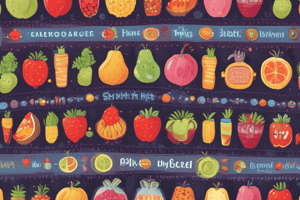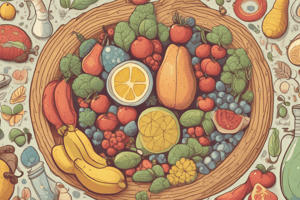Podcast
Questions and Answers
What is the difference between the glycemic index and glycemic load of a food?
What is the difference between the glycemic index and glycemic load of a food?
The glycemic index is a measure of how quickly a food raises blood glucose levels, while the glycemic load is a measure of the total amount of carbohydrate in a serving of food multiplied by its glycemic index.
What is the standard source of carbohydrate used to compare the glycemic index of foods?
What is the standard source of carbohydrate used to compare the glycemic index of foods?
50 g of glucose
Why might the glycemic load be a more realistic way of rating foods than the glycemic index?
Why might the glycemic load be a more realistic way of rating foods than the glycemic index?
Because the glycemic load takes into account the typical serving size of a food, providing a more accurate picture of its impact on blood glucose levels.
What types of foods tend to have high glycemic indices?
What types of foods tend to have high glycemic indices?
Signup and view all the answers
What is the purpose of ranking foods by their glycemic index?
What is the purpose of ranking foods by their glycemic index?
Signup and view all the answers
How is the glycemic load of a food calculated?
How is the glycemic load of a food calculated?
Signup and view all the answers
What observation in the early 1980s led to the development of the concepts of glycemic index and glycemic load?
What observation in the early 1980s led to the development of the concepts of glycemic index and glycemic load?
Signup and view all the answers
What is the significance of a food having a high glycemic index?
What is the significance of a food having a high glycemic index?
Signup and view all the answers
What is the difference between the glycemic index and glycemic load of a food?
What is the difference between the glycemic index and glycemic load of a food?
Signup and view all the answers
According to Table 5.12, what is the glycemic index of a Snickers candy bar?
According to Table 5.12, what is the glycemic index of a Snickers candy bar?
Signup and view all the answers
Why do critics think the GI and GL standards have limited usefulness as a menu-planning tool?
Why do critics think the GI and GL standards have limited usefulness as a menu-planning tool?
Signup and view all the answers
What is the association between high GI/GL diets and chronic diseases according to epidemiological studies?
What is the association between high GI/GL diets and chronic diseases according to epidemiological studies?
Signup and view all the answers
How can people with diabetes benefit from a low GI or low GL diet?
How can people with diabetes benefit from a low GI or low GL diet?
Signup and view all the answers
What is the benefit of eating foods with low GLs?
What is the benefit of eating foods with low GLs?
Signup and view all the answers
How does the effect of a food on blood glucose levels change when it is eaten as part of a meal?
How does the effect of a food on blood glucose levels change when it is eaten as part of a meal?
Signup and view all the answers
What is the benefit of a low GI diet in terms of cardiovascular disease?
What is the benefit of a low GI diet in terms of cardiovascular disease?
Signup and view all the answers
Study Notes
Glycemic Index and Glycemic Load
- Researchers in the 1980s discovered that the body digests carbohydrate-rich foods at different rates, leading to varying insulin responses.
- Foods with high fiber content are digested slowly and do not cause a dramatic increase in blood glucose and insulin levels.
What is the Glycemic Index?
- The glycemic index (GI) compares the rise in blood glucose after eating a food that supplies 50g of digestible carbohydrate to the rise after eating 50g of glucose.
- GI classifies foods based on their ability to raise blood glucose levels.
What is the Glycemic Load?
- The glycemic load (GL) is the grams of carbohydrate in a serving of food multiplied by the food's GI, divided by 100.
- GL may be a more realistic way of rating foods because it indicates the relative rise in blood glucose levels after eating a typical serving of a carbohydrate-containing food.
Classification of Foods based on GI and GL
- Foods with high GIs (70 or more) include sucrose, sugary foods, and highly refined starchy foods like cornflakes, baked potatoes, and white rice.
- Foods with low to moderate GIs (less than 70) include raw apples, carrots, spaghetti, fat-free milk, and peanuts.
- Foods with low GLs (less than 10) are considered beneficial, while those with high GLs (more than 20) may be detrimental to health.
Importance of GI and GL
- Critics argue that GI and GL values can vary too much depending on factors like food source, ripeness, and processing.
- Despite limitations, epidemiological studies suggest an association between high GI/GL diets and chronic diseases like obesity, type 2 diabetes, cardiovascular disease, and certain cancers.
- Low GI diets may improve blood lipid levels, reduce the risk of cardiovascular disease, and improve HbA1c levels.
Studying That Suits You
Use AI to generate personalized quizzes and flashcards to suit your learning preferences.
Description
Learn how carbohydrate-rich foods affect blood glucose and insulin levels, and how the glycemic index compares the impact of different foods.




